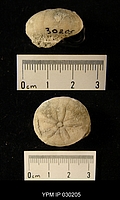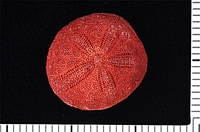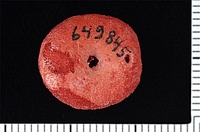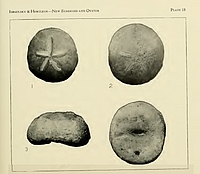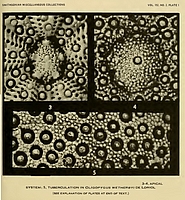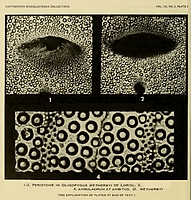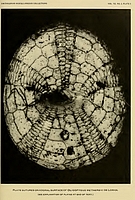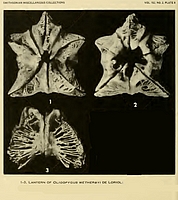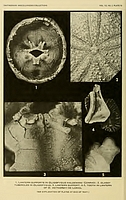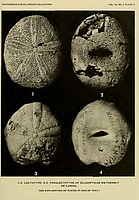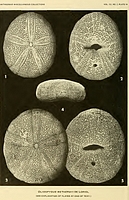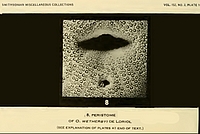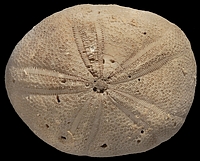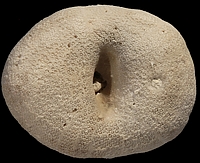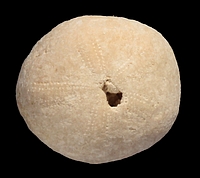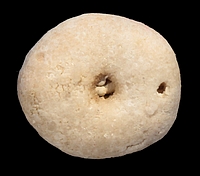Oligopygidae
Duncan, 1889, p.74
Genre type : Oligopygus de Loriol, 1888
Description succinte de la famille : système apical monobasal, quatre gonopores. Périprocte oral à marginal. Tubercules crénelés et perforés.

![]()
|
Oligopygus haldemani (Conrad, 1850) |
|
DISCOIDEA, Agass.
Locality. Bainbridge, Baker county. Mr Couper's note, accompanying this species, informs us that it is from limestone dug out of a well seventy feet beneath the surface. The specimens are mineralized crusts, one of which is nearly perfect. planche 1 (extrait) |
|
|
http://collections.peabody.yale.edu/search/Record/YPM-IP-030205 spécimen YPM IP 030205 crédit photo YPM Jessica Utrup |
|
|
|
![]()
|
OLIGOPYGUS PHELANI Kier, new species Plate 22; text fig. 9 Oligopygus haldemani Fischer (not Conrad), 1951, Florida Geol. Surv. Bull. 34, pt. 2, p. 56. Material.—The following description is based on the holotype and 57 topotypic specimens. Shape.—Small, elongate, width 83 to 88 percent of length, lengthwidth ratio quite constant (text fig. 9a) ; in smaller specimens marginal outline oval, in large specimens subpentagonal, pointed anteriorly, blunted posteriorly with greatest width anterior; largest specimen 18.5 mm long, average specimen 10 to 13 mm long, smallest 6.0 mm long; greatest height commonly at apical system, in some specimens anterior; height quite variable varying from 42 to 60 percent of length (text fig. 9b) ; adapical surface slightly convex, sides smoothly curving, adoral surface lacking deep peristomal sulcus, only depressed immediately around peristome opening. Apical system.—Central to slightly posterior; monobasal (pl. 22, fig. 3), madreporite strongly inflated, several tubercles on madreporite ; ocular plates small ; four genital pores, anterior pair closer together than posterior, pores large in some specimens small in others ; not visible in any specimens smaller than 8 mm long. Ambulacra.—Petals well developed, open in some specimens, straight, slightly closing in others; interporiferous zone widest in petal III where almost twice as wide as single poriferous zone; in other petals interporiferous zone slightly wider than poriferous zone; petal III longest with from 4 to 9 more pore-pairs in single poriferous zone than petals II or IV, 4 to 7 more than petals V or I; in largest specimen, 18.5 mm long, 23 pore-pairs in single poriferous zone of petal III, in smallest specimen, 6.0 mm long, 11 pore-pairs; outer pore of pair distal to inner; pores strongly conjugate (pl. 22, fig. 3) , in sutures between plates. Beyond petals, ambulacral plates single pored; at extremity of petal, pores very numerous in many included and demiplates; at ambitus pores most crowded in double series in each half-ambulacrum with continuous column of demiplates separating primary plates from adradial suture; a few included plates inserted between primaries and demiplates ; included and demiplates near adradial border, plates thin not extending through test ; nearing peristome primary plates extend to adradial suture, no included plates, one demiplate for each primary ; buccal pores difficult to see. Interambulacra.—Two columns in each area except at peristome where column terminating in single plate. Peristome.—Slightly anterior, central, or slightly posterior, opening slightly wider than high, in specimen 17.5 mm long, opening 2.18 mm wide, 1.94 mm high, opening (pi. 22, fig. 5) curved anteriorly, slightly pointed posteriorly; not in deep sulcus, test only depressed in area immediately around opening. Periproct.—Small, 1.4 mm wide in specimen 17.5 mm long, slightly wider than high; located between 54 and 73 percent of the distance from center of peristome to posterior margin. |
Tuberculation.—Test covered with small, irregularly arranged tubercles; scrobicules deep with vertical side; boss large, two-thirds diameter of scrobicule, extending upward as high as surrounding surface of test ; crenulated ; mamelon small, extending in height above surface of test, perforated ; crenulations and mamelon present only in well-preserved specimens ; small secondary tubercles scattered over area between tubercles. Location of type specimen.—Holotype USNM 649845 ; figured specimen USNM 649846. Occurrence.—Late Eocene, Inglis Formation, Florida : NW 1/4 NW 1/4 Sec. 30, & 17S, R20E, Citrus Co.; S. bank Withlacoochee River about 50 ft. SE of Hwy. 200 bridge at Stokes Ferry. Florida Geol. Survey loc. 1-5377, quarry in Citrus County south of Withlacoochee River one mile west of bridge at Inglis, Levy County; spoil banks along first 4 miles of Trans-Florida Canal near Inglis (loc. of holotype). Remarks.—This species is named for Thomas F. Phelan of the U.S. National Museum who first recognized that the specimens of Oligopygus from the Inglis Formation were different in appearance from those of the Crystal River Formation. Comparison with other species.—Specimens of this species have previously been referred to Oligopygus haldemani which occurs in the higher Crystal River Formation. Although O. phelani is very similar to O. haldemani in shape, having the same length to width and height ratios, and similar petals, it is easily distinguished from it by its lack of a deep peristomal trough and its more anteriorly situated periproct. In O. haldemani the peristome is in a deep transverse trough, whereas in O. phelani the test is only depressed in the area immediately around the opening. In O. phelani the periproct is located between 54 and 73 percent the distance from the center of the peristome to the posterior margin, whereas in O. haldemani it is located at 76 to 84 percent of this distance. Furthermore, O. phelani is a smaller species, the largest specimen being 18.5 mm long, whereas in O. haldemani the largest specimen is 37 mm long. O. phelani likewise differs from O. wetherbyi in lacking a deep peristomal trough. Its periproct is more posterior than in O. wetherbyi and its test is smaller. O. rotundus differs from O. phelani in having a broad and steep peristomal trough. planche 22 (extrait)
|
|
|
http://n2t.net/ark:/65665/3f2f67c0d-c98f-4623-a643-9b3313b3a08d spécimen USNM MO 649845 crédit photo Suzanne McIntire Kier, p. 81 pl. 22 |
|
|
|
|
Oligopygus phelani Kier, 1967 - Eocène supérieur, Crystal River Form., Ocala Group, Gainesville, Floride, U.S.A., 14 mm |
![]()
|
Oligopygus putnarni, Israelsky, new species Plate 18, figures 1, 2, 3, 4 Test tumid, thick walled; outline from above ovoid; ambitus rounded; madreporic system posterior to the center; petals reach about one-half the distance to the ambitus, tending to close distally, interporiferous areas strongly raised; greatest width of petals about one-third length; anterior unpaired petal slightly longer than paired petals, paired petals subequal; viewed from the side the outline is strongly arched above, higher anteriorly than posteriorly, and concave below; the peristome lies in a deep transversely elongate groove slightly behind the center; periproct about two-thirds the distance from peristomal groove to ambitus; surface apparently ornamented with stnall scrobiculate tubercles. Syntypes: Nos. 5210, 5211, Mus. Calif. Acad. Sci., collected by Lawrence G. Putnam., 12 kilometers northeast of Abasola, Tamaulipas, Mexico; upper Eocene. Topotypes: 5214 and 5215, C. A. S. type collection. Plasto-Syntypes: Nos. 422, 423, San Diego Society of Natural History type collection. Idiotypes: 424, 425, S. D. S. N. H. type collection. |
The new species appears to be more closely related to Oligopygus haldermani (Conrad) 1 than to any other thus far described. It may be readily distinguished from that foret by its more anterior periproct. The posterior position of the madreporic system appears to separate it from other species of the genus. The species may be the one found by Wise and Cavins in this same district, but not named by them. planche 18 (extrait)
|
|
Oligopygus putnami Israelski,1933 - Eocène supérieur, chiapas, Mexique, 31 mm |
|
Oligopygus putnami Israelski,1933 - Eocène supérieur, chiapas, Mexique, 26 mm |
![]()
|
Oligopygus wetherbyi de Loriol,1887 - Eocène supérieur, Sewanee Cty, Floride, U.S.A., 43 mm |
|
Oligopygus wetherbyi de Loriol,1887 - Eocène supérieur, Ocala limestone, Yankee Town, Floride, U.S.A., 14 mm |


